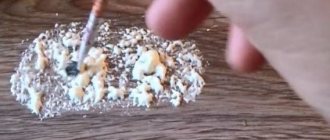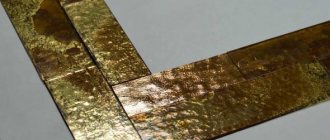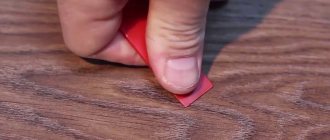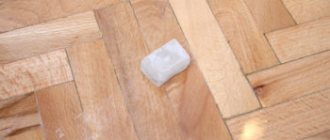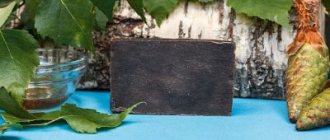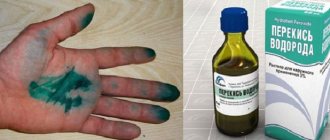Anyone who chooses laminate flooring should be prepared for the fact that sooner or later scratches will appear on it that will have to be masked. For this purpose, a special putty is produced for the laminate, with the help of which its cosmetic repairs are carried out.
Putty for laminate
Whatever one may say, such a floor covering cannot be called absolutely reliable, since it is not completely resistant to mechanical influences, especially abrasive and scratching ones. Even minor damage can be clearly visible. Moreover, a violation of the integrity of the coating in one place can often lead to further serious damage to the material over time. Therefore, if scratches or chips appear, they must be repaired immediately. In addition, in order to preserve the original condition of the laminated coating, it is advisable to treat it with a special agent immediately after installation.
Possible causes of laminate damage
Laminate is a very aesthetically pleasing, but rather “capricious” floor covering that requires careful use. The fact is that its protective top layer, although designed for a certain mechanical load, is very unstable to some external influences. When purchasing this material, you need to know what effects are detrimental to it.
- Most often, damage to laminate flooring occurs if it is laid in rooms with high levels of human traffic. At home, this is the hallway and corridor, since this is where dirt and sand are carried in from the street on shoes. And this not only stains the coating - small hard particles of dirt act as a very aggressive abrasive, abrading and scratching the surface of the laminate floor.
- Overmoistening of the coating plays a destructive role. Water seeping into the seams between the boards leads to damage to their structure - they can begin to delaminate or swell. Moisture also has a negative effect on the design of locking joints. The entire coating may become noticeably deformed at the seams or even go into waves.
- Rearranging pieces of furniture is one of the most common causes of deep scratches on laminate flooring. Such defects can expand over time, which can lead to deep damage to the board and the need to replace it.
The wheels of an office chair, especially if they are faulty, can leave scratches and abrasions on the surface of the laminate.
- The wheels of an office chair are also the “sworn enemy” of this coating, as they can completely erase the protective layer of the laminate over a fairly large area.
- Heels, especially those with metal heels, can also cause serious damage to laminate flooring. They can cause not only abrasions on the coating, but also serious scratches and even chips. This is another reason why it is undesirable to use laminate flooring in the hallway.
- The claws of large pets can also cause deep scratches on the surface.
- Falling objects can damage not only the protective coating, but also the hard layer of the board, leaving a dent in it. Heavy or sharp objects are especially dangerous for this material.
We eliminate gaps
If the cracks are insignificant, you need to take a special repair kit or prepare the composition using a “handicraft” method. The second option consists of: construction paint in a laminate shade, crushed chalk, sawdust and liquid glass. We dilute liquid glass with water, and then add the remaining components. Using a spatula, all existing cracks are well covered, then all this is cleaned with sandpaper and all that remains is to polish the coating.
Removing the shabby, dull look
It happens that laminate flooring needs updating even without severe defects. It’s just that the floor can lose its former shine, become dull and unattractive. Then the laminate needs to be polished using mastic, liquid polish or polish made on a viscous base.
We observe the following rules when polishing:
1. Carefully clean the laminate from dirt and dry thoroughly.
2
It is important to apply any sprays or viscous compositions evenly
3. Cloth napkins should be used.
As you understand, updating an outdated laminate flooring is not difficult using quite affordable means. The considered methods will allow you to keep the floor in its original form for a long time.
When starting to figure out how to remove scratches on laminate flooring, you should understand why the issues of minor floor repairs are so relevant. By examining the structure of the material in detail, you can also find ways to protect the laminate from damage. In this way, it is quite possible to significantly increase the service life of the coating and maintain its attractive appearance.
Why is this flooring so popular? Perhaps instead of determining how to remove scratches from laminate flooring, it should be for the floor? In fact, laminate flooring combines affordability with ease of installation, presentable appearance (good quality coating is difficult to visually distinguish from parquet) and resistance to household stains. It is easy to remove pen ink or other stains that may appear during use from the surface. Therefore, by learning how to protect and restore laminate flooring with low mechanical resistance, you can fully enjoy all its advantages.
Laminate consists of individual boards or tiles that can be laid end-to-end (special adhesives are used for fixation), or, which is the most popular option, boards with locks on the end parts, allowing you to install the covering quickly, easily and ensure reliable fastening of the elements.
This type of coating has a layered structure. The top protective layer – lamination – is what gave the material its name. Therefore, to determine how to repair scratches on laminate flooring, you should find out the depth of the damage.
- The smallest defects appear due to the abrasive effect of tiny particles - not only sand accidentally carried on shoes, but also dust. Such scratches worsen the appearance of the coating and reduce the protective qualities of the top layer, but do not damage the base material. If the integrity of the lamination is restored in time, the service life of the laminate floor will not decrease.
- Deeper damage to the laminate is caused by sharp heels, shoes with hard heels and the claws of pets. When it comes to a children's room, dropped metal, wooden and even plastic toys become an additional risk factor. In these cases, the lamination often gets scratched through and opens direct access to moisture to the base material (during cleaning, if water or a drink is accidentally spilled, etc.). Repairing scratches on the laminate in this case must be urgent, otherwise a small damage in area may increase in size in width and depth and turn into a crack.
- The most significant damage is cracks, chips, deep and wide scratches. It is almost impossible to restore such a coating; the only optimal solution is to replace the damaged area.
How to protect laminate?
Is it possible to protect laminate flooring from the threats that lie in wait for it? Manufacturers of various protective products claim that yes, this is possible if special compounds are periodically applied to the floor covering.
Laminate coated with a special protective mastic shows higher resistance to abrasive and scratching loads on it
On sale you can find various types of mastics that are designed to extend the life of this coating while maintaining external decorative qualities.
One example of high-quality protective mastic for laminate flooring
The mastic is applied immediately after installing the coating on the base. Having completed laying the laminate, it should be cleaned of dust using a vacuum cleaner, and then a layer of protective composition should be applied to the surface. This treatment of laminate flooring should be done two to three times a year. In this case, the coating will acquire the following qualities:
- The joints between adjacent boards will become more resistant to moisture penetration.
- The strength of the laminate joints will increase.
- The surface will not accumulate static electricity, which means it will not attract dust and dirt. That is, contaminants will not linger on the coating.
- The laminate will be protected to a certain extent from abrasion and minor mechanical influences.
- Mastic can also restore the former shine to worn out old surfaces.
Mastic is produced in a colorless version or in different color shades. Therefore, it will not be difficult to choose the right color or even, if desired, make the coating a shade darker.
A product based on natural wax for treating the joints of parquet, natural boards or laminate.
Wax is used to strengthen the joints of the laminate, and is applied to the locks when installing the flooring. Using a wax composition will prevent moisture from entering the seams between the boards.
In addition, wax and wax-based putties are also used to repair chips and cracks.
What to do if the laminate board is badly damaged and has a huge scratch on it
In this case, you will have to replace the damaged piece of laminate.
And here we have only 2 options for the development of events. First
— disassemble the floor (if the slats are not glued together) down to this board, replace it and lay the laminate again. For this we need a whole beautiful board to match. And if you don’t have any extra pieces left (in case you saved them) after installation, you can take them from under the furniture. It's still not visible there.
Sequence of work:
- Remove the baseboards around the perimeter of the floor;
- Carefully snap off the rows of laminate. It is advisable to mark the pieces with a pencil so as not to get confused later. To disassemble the first row you need to hook it with something;
- We remove the damaged board and replace it. Then simply put the floor back together and screw the baseboard.
Second
— remove the lamella separately without disassembling the entire covering. Again, we are looking for a replacement piece. In this case, you will need a bunch of additional tools. There will be a lot of dust, you will have to cut the laminate.
How to remove it is shown in the video:
Types of putties for laminate repair
In stores you can find a lot of products for masking cracks and chips in laminate flooring. Moreover, they are produced in different forms. All such materials can have different shades, which can differ by one or two tones or even differ significantly from each other.
An assortment of colors of wax bars for masking defects on laminate flooring.
Therefore, when going to the store, it is recommended to take a small fragment of the board with you so that the sales assistant can choose the exact shade to fill the crack. As a last resort, if a sample piece has not survived, you can take a high-resolution photograph, although such an image can often be deceptive.
The simplest remedy is a wax pencil. But it is only suitable for shallow surface defects.
- Wax pencil is used to mask cracks, crevices or shallow scratches. A restorative pencil is made from wax and polymers, which increase the adhesive properties of the composition when it adheres to the protective layer of the laminate. The crack must be thoroughly cleaned of dust, and then pressed over it with a pencil. The wax will fill the depression, after which the repaired area is polished until the coating returns to its original appearance.
Hard wax, usually sold in stick form, can be used to repair deeper defects in a laminate surface.
- Hard wax is sold in the form of bars that resemble plasticine. This material is convenient in that it can be used both in solid and molten form. In this case, different colors of wax can be combined with each other to achieve the desired shade, or, if necessary, darker colors can be applied to light putty. This type of wax can be used to repair deep scratches and chips in the decorative top layer of laminate flooring. In addition to wax, the bars may contain materials such as silicone, paraffin, various polymers, and dye.
- Mastic for laminate is used in cases where the surface is not fundamentally damaged, but has serious abrasions. It is applied with a brush and then rubbed with a soft cloth, or a small amount is poured onto the surface and then rubbed with a napkin.
Repair paste-mastic for laminate
- Laminate repair paste containing wax. This version of the formulations is sold in transparent tubes, which makes it easy to choose the desired shade. The convenience of this form of putty is that it does not have to be brought into the state necessary for application, since it already has the desired consistency. The paste is also produced in various shades.
Distribution of mastic or polish over the laminate.
- The polish, intended for tidying up the laminate, is used if abrasions appear on the surface of the coating, as well as after restoring the boards using a wax pencil, solid or molten putty. This restorative composition is sold in paste or liquid form.
Kit for deeper laminate repairs.
- To eliminate serious damage to the laminate, special kits are used, which may include putty, latex or acrylic compounds, wax pencil, etc. The composition of the kits may vary, so it is possible to choose the most suitable one.
The process of repairing a scratched area of laminate flooring
The procedure for repairing the laminate surface is completely simple and does not require special skills or expensive tools. However, in order for the result to be positive, when purchasing any of the products presented in construction stores, you must consult with the seller and also carefully read the instructions from the manufacturer.
For work, it is convenient to use the following devices: a wax melter, a special varnish with which the “felt-tip pen” container is filled, a wax spatula, the set of which includes additional devices - sponges, napkins, as well as a spatula cleaner.
A special tool for repairing laminated surfaces with hard wax - wax melter
The wax melter can have different designs and shapes. Homeowners whose floors are predominantly covered with laminate would do well to have this tool in their arsenal. By the way, it is useful not only for repairing floor coverings, but also for laminated surfaces of furniture.
Laminate repair kit.
The following will provide a step-by-step process for repairing a scratch on laminate flooring using Konig Super Hard Wax.
| Illustration | Brief description of the operations performed |
| Initial condition of the coating. In this case, a fairly deep scratch appeared on the laminate. Not only the protective layer of the board is damaged, but also the upper part of the base. | |
| In order for the putty to have good adhesion to the laminate, small fragments must be removed from the crack using a wax spatula with its sharp edge. At the same time, the scratch expands slightly. After which the recess and the surface around it must be degreased, for example, with alcohol, since the repair site must have good adhesion. Next, the scratch needs to be dried. | |
| The next step is to select the putty according to the color scheme. For this purpose, take several wax bars similar in color to the laminate. First of all, the base, lightest shade is selected, and to it one or two bars that match the tone. | |
| Now the wax melter comes into operation - this is a special tool that is convenient for repairing coatings. The device operates on batteries. | |
| The wax melter is equipped with a metal nozzle, made in the form of a spatula, which is temporarily protected by a cap. Before starting work, the cap is removed. | |
| Next, the button that activates the heating of the metal tip is pressed and held in this state for approximately 10÷12 seconds. | |
| Using a heated nozzle, the base wax putty melts. For such a scratch you will need a small amount. If the color of the putty is slightly different from the shade of the surface, then it is necessary to mix two or three colors of wax. As a rule, laminate does not have a single color, so sometimes the length of one scratch even requires changing the shade of wax several times when filling it. | |
| Fill the scratch with small portions of heated wax. Fill the scratch with excess, since the wax will shrink as it cools. If the tip of the wax melter gets very hot and the wax starts to smoke, you should release the heat-activating button to reduce the temperature. | |
| After each application of wax of a certain shade, the working tip must be cleaned with a clean cloth. | |
| After the wax hardens, after about 30-50 seconds, excess putty that protrudes above the surface of the coating should be removed using a wax spatula. | |
| To do this, use its ribbed side, which will not damage the main coating, but will gently remove excess wax. | |
| This operation is performed with rubbing movements across the repaired scratch. Do not press the spatula too hard. | |
| The result of the work will be a scratch covered with putty, which should look approximately as shown in the photo. | |
| If the scratch passes through darker or lighter veins, then putty bars of a suitable color are taken. The selection is also made by location so that the color is perfect. | |
| Next, a textured pattern imitating the structure of wood is applied over the filled scratch using the same heated tip of a wax melter. This stage of work requires care and high precision, since using a working tip you will have to try to recreate the original pattern of the laminate surface. | |
| After the putty hardens, its excess is also removed using a spatula. To do this, the protruding wax is wiped with the ribbed side of the instrument. | |
| Here the master shows what marks can remain on the spatula. After treating the surface, the spatula comb must be immediately cleaned with a napkin or a special device included in the kit, which is stored in the tool body. If the wax on the putty knife hardens, it will be difficult to clean and will interfere with subsequent work or when repairing other areas of the coating. | |
| The next step is to sand the repaired scratch with a gray sponge, which is also included in the spatula kit. | |
| Further, if necessary, the surface is additionally cleaned with the pointed side of the spatula. | |
| The next step is to coat the surface with a special varnish. It will protect the putty from dust and give the repair area the desired shine. A cylindrical container similar to a marker or felt-tip pen is filled with varnish. It is equipped with a brush, which is convenient for applying varnish to a small area of the coating. | |
| Before using the varnish, the pencil container must be shaken for 30-40 seconds, so that the knocking of the balls located in the container with the varnish and intended for stirring it can be heard. In order to ensure the purity of the applied varnish, it is necessary to remove the cap from the pencil and dip the brush in water. This is necessary to remove dust and loose fibers from the brush. A wet brush must be wiped with a clean cloth. Next, you need to press on the walls of the container to remove air from it. | |
| The pencil container must be held vertically and gently pressed in the area of the “PRESS” inscription. It is better to carry out this process over a napkin so that splashes of varnish do not fall on the surface of the floor covering. Then, if the varnish does not enter the tip, the container must be turned over with the brush down, placing a napkin under it, and press “PRESS” again. Excess varnish that appears must be wiped off with a napkin. Now a thin layer of varnish can be applied to the repaired lamella. When applying varnish, the brush must be periodically wiped on a napkin. | |
| To ensure that the shine of the area is commensurate with the main surface, it can be corrected using a polishing and sanding pad. | |
| The pad has two sides - white and green. Green adds shine to the surface, and white, on the contrary, serves to create a matte effect. Therefore, the surface is first treated with the white side of the material, and then, to give it a natural look, it is sanded with the green part of the pillow. | |
| These illustrations show the result of the work carried out. So that it could be assessed, the master showed nearby a scratch that had formed on the coating before it was repaired and after it was sealed with a complex of putties of different shades. |
It should be noted that some Internet users, accustomed to relying on their own ideas, offer other budget options for repairs. For example, using ordinary felt-tip pens or markers, you can give the scratch the desired shade, and fill the indentation with natural wax, melting it with a soldering iron. If necessary, the wax is melted and dye is added to it, and then applied to the damaged area of the coating. After hardening, the repaired scratch is sanded and varnished.
There are quite a lot of other home recipes, but all of them do not guarantee that the desired result will be achieved. Using untested means can completely damage the coating, which will lead to the need to replace several boards.
Industrially produced laminate repair products are designed taking into account the characteristics of protective coating materials. Therefore, they have excellent adhesion to the laminated surface, making the resulting defects almost invisible for a long time.
Find out about the reasons why laminate flooring creaks and methods for eliminating them from our new article on our portal.
However, each master chooses the most convenient and affordable method of repairing surfaces. Therefore, if you want to experiment, it is better to do it on a fragment of the laminate left after its installation, or, as a last resort, in an inconspicuous area of the coating.
Which putty is better?
The domestic market offers a sufficient range of various materials for repairing and maintaining the laminate surface. Almost all of them do an excellent job. One of the most important points to achieve the desired result is choosing the right shades of wax or other repair products.
The most popular materials for laminate restoration are German and Dutch “Quick-Step” products. Both companies produce putty in the form of paste, wax bars and pencils, as well as in special kits.
Repair kit “Quick-Step Mix & Fix” for repairing scratches on laminate and parquet.
Companies present on the market 24 shades of wax putties that mix well with each other. Therefore, if desired, you can achieve any color that will effectively mask the flaws that have appeared.
How to avoid defects on a laminated floor surface?
Having chosen a laminated covering for flooring in an apartment or house, you should immediately provide for its protection. It would be a good idea to do this after the surface has been repaired, so that you don’t have to work on scratches and chips again.
These activities are simple and consist of the following steps:
- When cleaning the coating, do not use detergents containing abrasive ingredients.
- If laminate is laid in the hallway, then you should definitely lay rugs on both sides of the front door, that is, outside and inside the home.
- To protect the laminated covering from the wheels of the office chair, it is recommended to lay a thin but durable flooring that fits well to the surface in the area where it moves. This can be a rubber-based mat or acrylic glass.
Acrylic glass as protection of the floor covering from abrasion by the wheels of an office chair
- It is also necessary to protect the laminate from the legs of furniture, especially those that are frequently moved (chairs, tables, stools, etc.). To do this, felt, vinyl or polyamide pads are glued to the ends of the legs.
- You must remember to periodically use polish or mastic for laminate flooring to treat the surface. These products create a protective film on the coating, which additionally protects it from minor mechanical influences.
Check out the tips for homeowners on how to choose a laminate flooring class from our new article on our portal.
* * * * * * *
As you can see, there is nothing complicated about preventive measures - they are easy to implement. If you don’t want to make certain efforts to preserve the laminate flooring, then you should immediately abandon the idea of choosing this particular material. Without proper care, it will quickly become unsightly or even completely unusable.
At the end of the publication, there is a video in which the master shows a slightly different method of repairing a laminated surface.
The second way to level a wooden floor
The second method is to use joists on which the floor boards are attached. This method should be used only if the old boards have become unusable, and the logs themselves are still in excellent condition. The process consists of the following steps.
- Removing old floor boards. Everything is clear here; old boards are removed using a nail puller and a hammer. In this case, you must not damage the logs to which they are attached.
- Insulation of the base. A layer of expanded clay is first poured into the space between the joists, on top of which foam is then laid. The insulation must be laid tightly, filling the entire free area between the joists. The joints between the plates can be treated with special mastic or filled with polyurethane foam.
- Laying plywood. The final stage is laying the plywood. The sheets are attached to the joists using self-tapping screws. The step between the fasteners should be 15-20 cm. After this, the backing and laminate are laid on the plywood.

